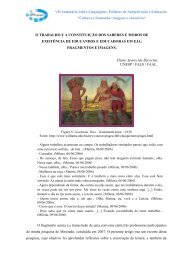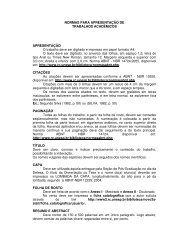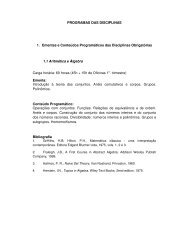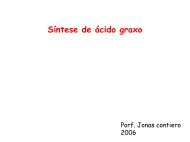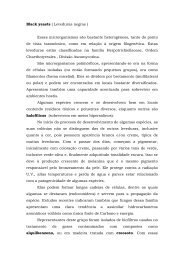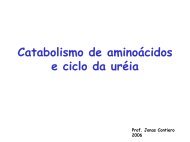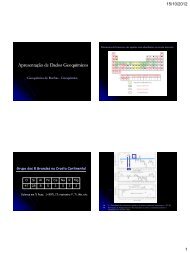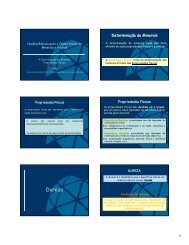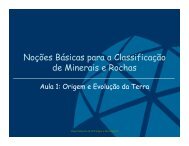Diet and Spatial Pattern of Foraging in Ectatomma opaciventre ...
Diet and Spatial Pattern of Foraging in Ectatomma opaciventre ...
Diet and Spatial Pattern of Foraging in Ectatomma opaciventre ...
You also want an ePaper? Increase the reach of your titles
YUMPU automatically turns print PDFs into web optimized ePapers that Google loves.
614 Sociobiology Vol. 58, No. 3, 2011<br />
<strong>and</strong> roots) <strong>in</strong> the diet <strong>of</strong> E. brunneum (=quadridens). A preference for ants<br />
was also observed <strong>in</strong> E. permagnum, which showed a diet consist<strong>in</strong>g almost<br />
exclusively <strong>of</strong> workers <strong>and</strong> w<strong>in</strong>ged <strong>in</strong>dividuals <strong>of</strong> Pheidole <strong>and</strong> Camponotus<br />
(Paiva & Br<strong>and</strong>ão 1989), <strong>and</strong> <strong>in</strong> Pachycondyla striata, which <strong>in</strong>cludes <strong>in</strong> its<br />
diet foragers <strong>of</strong> Odontomachus, Camponotus, Pheidole, Solenopsis, Atta, <strong>and</strong><br />
even other Pachycondyla (Medeiros & Oliveira 2009).<br />
The proportion <strong>of</strong> ants preyed on by E. ruidum was observed to be similar<br />
both <strong>in</strong> the dry (18.8%) <strong>and</strong> <strong>in</strong> the ra<strong>in</strong>y (17.2%) season. Although its diet<br />
consisted <strong>of</strong> 19 items, almost 30% <strong>of</strong> them corresponded to liquids rich <strong>in</strong><br />
carbohydrates, such as extrafloral nectar, honeydew, <strong>and</strong> fruit pulp (Lachaud<br />
1990). Similarly, <strong>in</strong> E. tuberculatum, liquid foods represented more than 35%<br />
<strong>of</strong> its diet (Valenzuela-González et al. 1995). Collect<strong>in</strong>g resources <strong>of</strong> animal<br />
orig<strong>in</strong> requires longer forag<strong>in</strong>g distances; captur<strong>in</strong>g <strong>and</strong> transport<strong>in</strong>g them<br />
is more time consum<strong>in</strong>g compared with liquid foods (Harkness & Harkness<br />
1976; Fourcassié & Oliveira 2002). This “preference” for other ants is not<br />
likely to be due to selectivity by the foragers, but to the low diversity <strong>of</strong> food<br />
items available <strong>in</strong> the environment. This can be proved <strong>in</strong> the laboratory, s<strong>in</strong>ce<br />
workers <strong>of</strong> E. <strong>opaciventre</strong> easily accept other food items, such as mealworms,<br />
which are not found <strong>in</strong> their natural environment.<br />
The predatory behavior observed <strong>in</strong> E. <strong>opaciventre</strong> was very similar to that<br />
found by Pie (2004) <strong>in</strong> the Brazilian savanna <strong>and</strong> by T<strong>of</strong>olo <strong>and</strong> Giannotti<br />
(2009) <strong>in</strong> the laboratory: prey aggressiveness determ<strong>in</strong>ed the type <strong>of</strong> approach<br />
used by the workers. As a consequence <strong>of</strong> the absence <strong>of</strong> recruitment previously<br />
described for this species, the size <strong>of</strong> the food item collected was dependent<br />
on the capacity <strong>of</strong> the worker to carry it without help, one at a time. This<br />
behavior is characterized as social facilitation, that is, the return <strong>of</strong> a forager<br />
to the nest that may <strong>in</strong>crease activity <strong>in</strong>side the nest, lead<strong>in</strong>g other collectors<br />
to leave <strong>and</strong> search for food sources even <strong>in</strong> the absence <strong>of</strong> a chemical trail or<br />
any other directional <strong>in</strong>formation, as observed <strong>in</strong> Pachycondyla goeldii (Orivel<br />
2000) <strong>and</strong> E. ruidum (Lachaud 1985).<br />
In the degraded area studied, the foragers <strong>of</strong> E. <strong>opaciventre</strong> did not stay<br />
more than 5.14 m away from the nest. A similar behavior was observed by<br />
Medeiros <strong>and</strong> Oliveira (2009) <strong>in</strong> numerous colonies <strong>of</strong> Pachycondyla striata.<br />
Fourcassié <strong>and</strong> Oliveira (2002) reported that, <strong>in</strong> D<strong>in</strong>oponera quadriceps,<br />
this distance was more than twice as long, reach<strong>in</strong>g 13 m. Pie (2004) also




